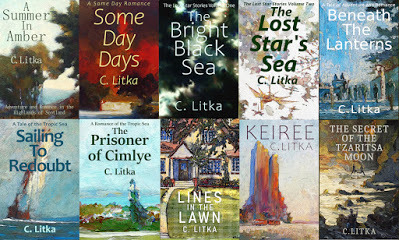C. Litka's Blog, page 46
March 26, 2021
Just a note to mention that I have written two essays fo...
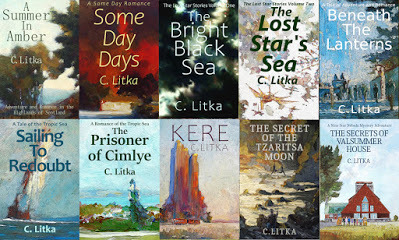
Just a note to mention that I have written two essays for the blog site Writers Supporting Writers. The first essay is about mixing and matching the conventions of the various versions of English in one's writing. It can be found here Using the World of Englishes
The second essay asks this question of writers; could you recognize your characters if you ran into them on the street? In short, how clear of a picture do you have of the characters you create, or for that matter, you read, as well as my approach to characters. It can be found here: Would You Recognize your Characters
March 18, 2021
The Secrets of Valsummer House
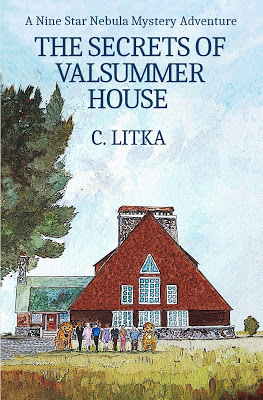
My latest novel, The Secrets of Valsummer House is now available on Smashwords (for free) and Amazon (for $.99, their minimum price). It will be coming to Google, Apple, Kobo and B & N in the coming days. Lt Di Ai and d'Mere return in this Nine Star Nebula Mystery Adventure that is the direct sequel to The Secret of the Tzarista Moon.
This is my mystery story. I'm not a mystery story fan these days, in large part because I grew weary of every mystery involving a murder, or two, or three. Now it may be exactly what mystery fans expect, and perhaps demand in their mysteries. But I think it's just laziness on the part of mystery writers. I would think that you could come up with a compelling mystery without it involving a murder. And, well, I set out to prove that theory in my mystery, The Secrets of Valsummer House. Did I succeed or not? That's up to you, dear readers. Let me know.
And, if all goes well, there's one more mystery story coming this summer with Vaun Di Ai and Rafe d'Mere. I'm going to try to give it some Gothic vibes. Werewolves, vampires... we'll see...
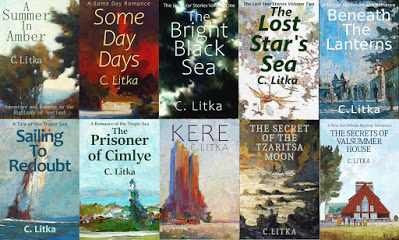
My latest novel, The Secrets of Valsummer House is now av...

My latest novel, The Secrets of Valsummer House is now available on Smashwords (for free) and Amazon (for $.99, their minimum price). It will be coming to Google, Apple, Kobo and B & N in the coming days. Lt Di Ai and d'Mere return in this Nine Star Nebula Mystery Adventure that is the direct sequel to The Secret of the Tzarista Moon.
This is my mystery story. I'm not a mystery story fan these days, in large part because I grew weary of every mystery involving a murder, or two, or three. Now it may be exactly what mystery fans expect, and perhaps demand in their mysteries. But I think it's just laziness on the part of mystery writers. I would think that you could come up with a compelling mystery without it involving a murder. And, well, I set out to prove that theory in my mystery, The Secrets of Valsummer House. Did I succeed or not? That's up to you, dear readers. Let me know.
And, if all goes well, there's one more mystery story coming this summer with Vaun Di Ai and Rafe d'Mere. I'm going to try to give it some Gothic vibes. Werewolves, vampires... we'll see...

March 17, 2021
Keiree is FREE on Amazon
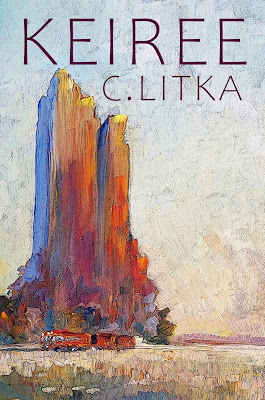
Oh those wacky algorithms over at Amazon! I noticed that Keiree, which, for some unfathomable reason, they did not price match to free along with all my other books, is now FREE. However, the balance of the universe must be maintained, so The Lost Star's Sea is now at my low list price of $.99, taking its place as my one non-FREE book.
Tomorrow, 18 March 2021, that will change again with the ebook release of my newest Nine Star Nebula Mystery Adventure, The Secrets of Valsummer House at $.99 We'll see if they reduce it to FREE once it is out in all the other stores. The paperback book of The Secrets of Valsummer House is now available for $10.00 on Amazon.
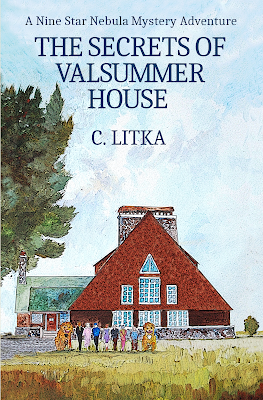
March 12, 2021
One Approach to Writing
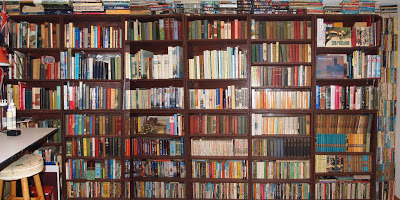
My intention was to write an essay contrasting my approach to constructing a story – using familiarity and intuition – vs constructing a story from a blueprint of acts, pinch points, reversals, and such. However, that idea rather jumped the tracks when I began to talk about talent as an ingredient in writing, well before I really got to the original subject of the essay.
So, here’s a sort of preamble to that discussion.
I really dislike the term “self-taught,” as in “a self-taught artist.” As a so-called self-taught artist, which is to say, someone who has never taken a course in art, I can tell you that I didn’t teach myself anything. I just learned. I learned by doing. And by doing it over and over again. I learned by looking at the painting of other painters in books. I learned, when I took up oil painting, by looking over books on oil painting techniques, and how to stretch canvas, and such matters. But again, mostly I learned by painting.
And yet, would all that doing and doing have amounted to anything if I didn’t have something else? Something else that can’t be learned. If I didn’t have a “talent” for art? If I didn’t have an aptitude that attracted me to creating pictures with paint and kept me doing it, year after year, decade after decade? I must admit that I think talent is something that can’t be learned. But I could be wrong.
(I will grant you that whether or not I have a talent for art is open to debate. But you can never please everyone, and I don’t try. And my work certainly doesn’t please everyone. But I’m quite comfortable with that.)
Which brings me around to writing.
I enrolled in college as a journalism major because I dreamed about being a writer. But I soon realized that I was far too shy to ever be a journalist, so I changed my major to international relations. I decided that if I had the talent to write, I could become a writer without going to school to learn how. Rightly or wrongly – and even if I couldn’t spell English. (This was long before word processors and personal computers.) I still believe that today.
Since those far gone days, I have approached writing in the same spirit as I approached art. I did it again and again over the years. I have a small collection of rejection slips for the SF magazines of the ‘70’s for a novella, and one for the fantasy novel I wrote. I wrote many “noses” of stories, never getting beyond a few pages. I recently tossed a box full of notes, drawings, and file cards for a SF novel from the 80’s that I never got very far on writing. And I still have a manuscript for a YA adventure novel from the 90’s, the revised version lost when the computer it was on lost power.
So, like in art, I’m a “self-taught” writer. But in the case of writing, it was not just writing, but reading that shaped me into the writer I am today. I have a wall of books, and with all the library books I read, I must have read nearly 2,000 books over these last 60 plus years. I believe that in reading all those books I absorbed on an intuitive level, the art of storytelling. And when I write, I am intuitively recreating the structure and experiences that I encountered, remembered, and enjoyed in all those books that carried me off and away into their worlds of words.
So not only am I a self-taught writer, but an intuitive one as well. I think of a story to tell, piece it together scene by scene as it seems to me it should be told, without thinking much, if at all, of that process. Which brings me around to the subject I set out to talk about – engineering stories. Which is to say, breaking stories down in to discrete pieces – into blueprints like three act plays or hero’s journeys, and components and techniques that build tension, conflict, with turning points, pinch points, reversals, and all the other terms and techniques you can find set out in books, articles, and blog posts on how to write stories. Concepts, which, I must confess, are much like English grammar to me – a mystery.
But I find that I have rambled on too long already to do the subject justice. Plus I really need to do some research into how to write a story this way. So I’ll save my thoughts on constructing stories vs my more intuitive approach for a future blog.
The Secrets of Valsummer House release date: 18 March 2021! Be there, or be square.
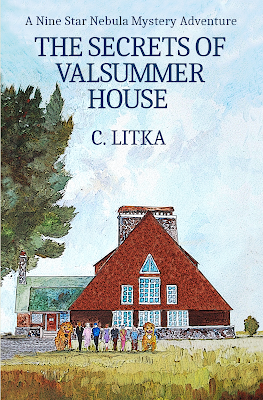
March 5, 2021
The Secrets of Valsummer House Release Date
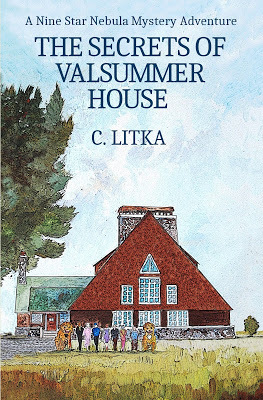
The Secrets of Valsummer House, the next Di Ai and d'Mere mystery story is now up for pre-order on Amazon, the ebook priced at $.99. It will be released on 18 March 2021 It will also be released as a trade paperback book for $10.00.
It will also be released on Smashwords, Apple, Kobo, B & N and Google on that date, or within a day or two, once again for FREE on those sites. Whether Amazon will match that price or not, is always up to Amazon.
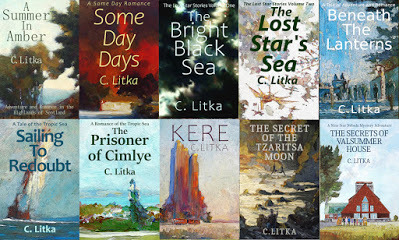
February 27, 2021
A Map for Tzarita Moon and Valsummer House
 Note: not to an exact scale
Note: not to an exact scaleAbove is a map for the two Nine Star Nebula Mystery Adventure stories to date, The Secret of the Tzarista Moon andThe Secrets of Valsummer House. I don’t include maps in my ebook editions as I don’t know how they will display, and are a pain to find when you need them in an ebook. So if you would like a map, you can download and print this map – and any of my other maps out to use alongside your reading.
I don’t really think either story actually needs a map, but a map is always handy. I like maps in books.
I do, however, need to up my map making game. I know that there are may how-to-do map videos on Youtube that I can use to improve my map making skills, so I’ll have to watch some of them, some time. They tell you not only how to do draw maps, but where to find the resources you can use to make map making easier. For example, where to find things like parchment backgrounds, and map features – mountains, hills, cities, forests, etc. that can be downloaded and used.
Prior to making the map above, I would draw my maps on paper. I would then take a photograph of it. I would open the photo up in Gimp on my computer, straighten up any lens distortions, and add the colors and lettering.
I recently purchased a 13” chromebook and a digital pen to use with it, which is what I used to make part of the map above. You can now install Linux programs on a chromebook, so I installed the Linux version of Gimp and used it to draw and color the map above. I then emailed that version to myself and opened it up on my main computer with a larger monitor to touch it up and add the lettering. So this is my first map done entirely digital.
On The Secrets of Valsummer House, it is currently being beta read. My tentative release date looks to be 18 March 2020.
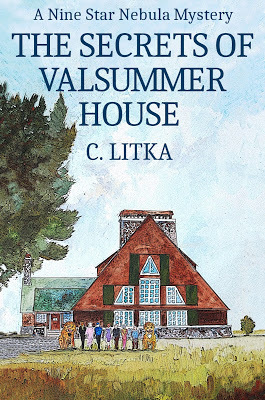
February 20, 2021
The Secrets of Valsummer House Cover
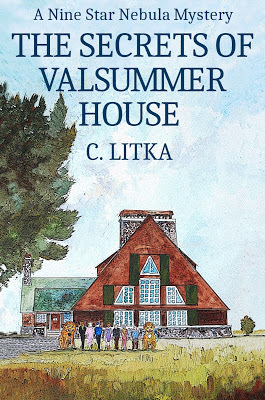
Now that The Secrets of Valsummer House is in the proof/beta reading stage, It is time to tackle the cover art. I have remarked in other post how, after painting several thousand paintings in my life time, I’ve lost the will, the skill, and the enjoyment of painting. Which means that painting a new cover is now a chore, rather than a pleasure Above is my current cover art. (At the time I’m writing this, I haven’t even started it yet, so I don’t know how terrible it is. Yet.) Above is the second version of the cover. At the end of this post I'll post the first more terrible version.
Cover aside, this story is my attempt at writing a straight up old fashioned mystery story. I used to read mysteries. But I grew weary of them because everyone seemed to involve a murder of one sort or another. Conan Doyle’s wrote delightful Sherlock Holmes mysteries that did not involve solving a murder, but it seems that mystery writers soon grew lazy and decided that the easiest way to make and raise the stakes in the story was to have it involve a murder – and often a series of murders. Maybe this is because mystery readers (and editors) expect, and perhaps even demand, a murders in their mysteries. I don’t know. I do know that very few mystery authors make a mystery out of anything else but some sort of murder. And if they do, they might not even be considered mysteries. Correct me, if I am wrong, for as I said, I stopped reading them decades ago.
One of the reasons why I started writing stories is that I’d occasionally come across books that made me wonder just who in the publishing business owed the writer a big favor. I was certain I could write a better story than some of the traditionally published books I came across. But talk is cheap, and so I set out to see if I could do better. I’d like to think that I have. And in that same vein, I took up the challenge to write a compelling mystery that isn’t about a murder. And to write it like an old fashioned mystery, where finding clues, talking to “suspects”, being misled by red herrings, and the like, take precedence over action scenes. While I consider the first book in this series, The Secret of the Tzarista Moon, a sort of cozy action/mystery story, I wrote this book as a mystery to be solved story. Does it work without a murder? We’ll see…
Look for The Secrets of Valsummer House to be released sometime in the last half of March 2021.
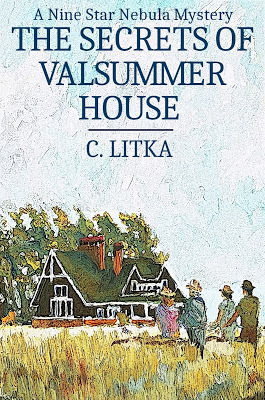
February 13, 2021
My Library -- The Sea Books (Part One)
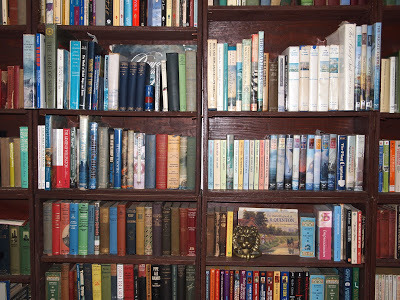 My Sea and Ship Book Shelves
My Sea and Ship Book Shelves
I never ran away to sea. I am not a risk taker. My definition of a real world “adventure” is an unpleasant incident in the past. I’m not one to seek out those unpleasant experiences. Except, of course in books. However, if I was a risk taker, I think running away to the sea would’ve suited my taste for adventure.
As you can see from the picture above, I have several shelves of books related to the sea, ships, and shipping, both fact and fiction. Too many to cover in one post, so I think I’ll focus on just one author and one type of book – Basil Lubbock and clipper ships, especially tea clippers. My first introduction to tea clippers was from the book The China Clipper, pictured below.
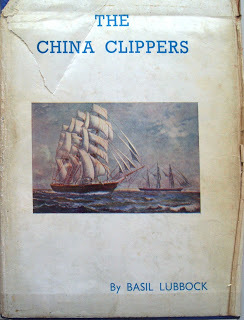
To tell the story of how I came to discover the book, we need to turn the clock back to 1969, and my sophomore year at the University of Wisconsin. That was the year they decided to let underclassmen into the stacks of the University Library. Prior to that, if you wanted to take out a book from the library, at least as an underclassman, you had to go to the card file, find the book you wanted by riffling through the cards and then make out and hand in a written request for it. Someone would then fetch it for you. In my sophomore year, the opened the stacks to everyone.
The stacks of the University Library was a wonderful, almost never-land sort of place. Six or more dimly lit floors of books, with little study cubicles to read them. I spent many hours just wandering through the stacks. Early on I searched out the nautical and naval history section. In high school my friends and I had been fighting naval battles on our basement floor with 1:1200 metal models of warships. Each of us collected ships of a different navy. I had, and still have, the warships of the Royal Navy. The game was played with rules invented by Fletcher Pratt. Yes, that Fletcher Pratt, the science fiction author. The game involved moving your ships, aiming at the enemy, and then writing down and assigning your ship’s volley an estimated range, which was then measured out with a tape measure. Inverted golf tees were used to indicate where your shells fell. Great fun.
Well, I’m off course again. Suffice to say that naval history drew me to the section of the nautical history section of the stacks. I was studying Chinese and East Asian history, and had begun to drink tea, on occasion, so I have to believe the title of the book, The China Clippers, and the subject – tea clippers is what enticed me to began reading the book when I spied it on the shelf.
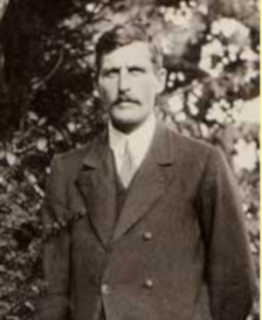 Basil Lubbock
Basil Lubbock
Basil Lubbock was an adventurer, Though educated at Eton, he did not go on to university, but instead, sailed for Canada. He joined the Yukon gold rush, sailed as a sailor in sailing ships, soldiered in the Boer War and WW l and played cricket. His histories of the ships and trades were often gathered from correspondence with the people who sailed on them. At any rate, they were anything but dull academic reading. The China Clippers and his Log of the Cutty Sark brought the romance of the tea clippers to life for me.
In fact, I invented a China Clipper race game that covered the treacherous South China Sea, that seemed to reproduce the recorded times pretty well. I think I still have that as well. I never bothered to go beyond Anjer, and on into the Indian, South Atlantic, and North Atlantic Oceans with the game, to take the race all the way to its finish line, the London dock., But it was sailing the South China Sea that usually made or broke a rapid journey home to London. But I’m off the rails again...
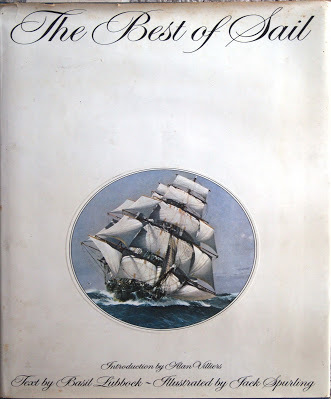
Anyway, Lubbock went on to write a number of books, both fact and fiction, regarding the life and trade of the hay day and decline of the sailing ship that you can see in the photo above. He also wrote entries for the sailing ships that Jack Spurling painted for the magazine Sail, and which were collected in the large book, The Best of Sail. I’ve included some of Jack Spurling’s wonderful sailing ship paintings below.
 The Tea Clipper Taeping
The Tea Clipper Taeping
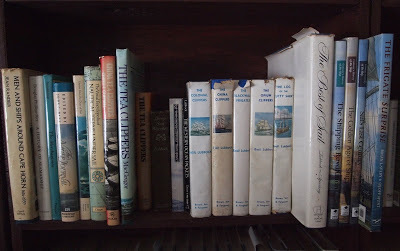
Over the years I’ve collected several other books on the China tea clippers, see my shelf above. As well as books on sailing ships in general. Over the years, their stories have served to inspire a number of my stories, published and unpublished. Indeed, I must admit that a sea story disguised with spaceships has always been one of my favorite types of stories. Which is why I wrote one myself.
 Tea Clipper Arial
Tea Clipper Arial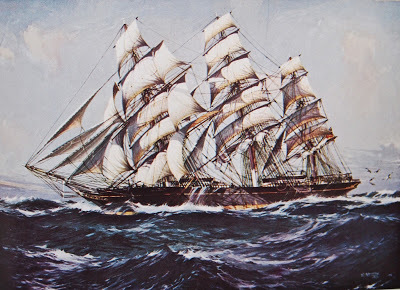 Tea Clipper Cutty Sark
Tea Clipper Cutty SarkI'll get around to writing about some of my other favorite authors of sea stories -- C.J. Cutcliffe Hyne, W Clark Russell, Guy Gilpatric, and Patrick O'Brian at some future date.
In other news, I finished the second draft of The Secrets of Valsummer House. I expect to have the third and hopefully final draft ready for proofreading my next weekend. We'll see.
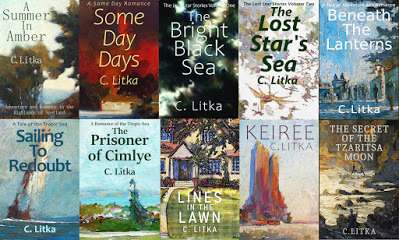
February 6, 2021
The Secrets of Valsummer House Blurb
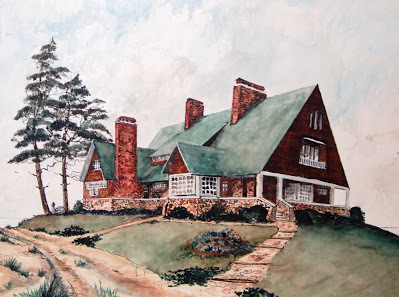 Prototype of Valsummer House, details vary from book description
Prototype of Valsummer House, details vary from book descriptionI realized last night at 9:30 that I had not written the blog post I had planned to write for this week and that I didn't have the time to write it and take the photographs. So it's a quick substitute post this week -- the first version of the blub for my next book, along with a photograph of an early version of what will be Valsummer House which I painted decades ago.
The house I picture above is very similar to the title house in the book as far as its general style. However its details and setting will be different in the book. Still this gives you the general idea of how I envision it.
I've began working on the second draft, with a goal of doing a chapter a day. Despite being free to make any changes I care to, I find that I generally follow the first draft, just tweaking my writing. I have a tendency to write run on sentences, so that these days, I make a special effort to break them up and eliminate a lot of "ands." I also seem to write a lot of sentences backward. I don't know enough about the mechanics of English to say exactly what I'm doing, but I think its a byproduct of working an idea through while I'm writing it down. Once I have it down, I can then go back and tweak it to read better.
Anyway, I'm going to keep this post short. Work is going well on the second draft. I've made a few more extensive changes to reflect the evolution of the story as I went along. And I expect to spend more time reworking things as I go along since I've gone over the first few chapters several times during the those periods when I had to stop and collect my thoughts on how to proceed. All in all, I expect to be able to release the book towards the end of March 2021.
Below is the first draft of the Blurb. This will change over time as well.
The Secrets of Valsummer House
A Nine Star Nebula Mystery
The Secrets of Valsummer House is the direct sequel to the Secret of the Tzarista Moon, picking up the story several months after the conclusion of the first book. Sleepy Pine Cove has been transformed into a lively resort town with the arrival of the summer people. Rafe d’Mere is happily fixing toasters, bots, and appliances, when who should arrive, but one Lieutenant JG Vaun Di Ai, to his alarm and delight. She assures him that she is there merely to tick off some boxes on the case forms, and follow up on a few leads that the interrogation of the Seven Syndicate members rounded up at the end of the last story provided. She further assures him that she has strict orders to do nothing but tick boxes or risk her career in the Patrol. Basically, she is, in her own words, “An intelligence analyst 3 on a field trip.” So he has nothing to worry about. But knowing her, of course he does. With good reason.
The Secrets of Valsummer House is written as an old-fashioned “whodunit” style of mystery. First we have the arrival of a mysterious crate containing an “antique” robot whose delivery was mysteriously delayed – for years. And then, Di Ai arrives on her mission, followed by the arrival of a rather mysterious lady a day later. All of them connected in one way or another. Toss in the other Pine Cove characters from the first story, the Seven Syndicate, and its leader, the pirate prince known only as Seven, and you have a tangled web of intrigue and mystery to be discovered and unraveled.
I like to do something a little different with each book I write. This time around, it’s a pretty pure mystery. There’s a lot less plasma darts flying about in this story. It is pretty much a story of uncovering connections and following clues to unravel the mystery of the bot, the mysterious woman, and the pirate prince of the Seven Syndicate.
